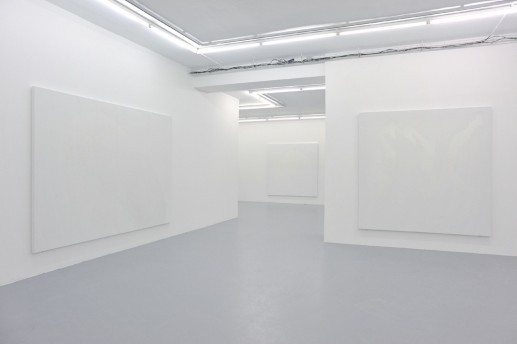Daniel Lergon
22 Jan - 19 Feb 2011
DANIEL LERGON
Whiteout
22 January - 19 February, 2011
In a whiteout we lose our sense of direction, contours disappear and we are no longer able to see the horizon. Encountering a snowstorm or a polar landscape causes our eyes to pulsate while losing focus and trying to regain control in surroundings that are simultaneously empty and compact. Our reliance upon vision has to give way to other senses and a sharpened attention to our inner experience of the monochrome landscape ensues.
Whiteness factors crucially in our existence: in the strong rays of daylight, in the essential first nourishing drops of milk, in the white flag offering peace, in a sheet of white paper that carries an artist’s deliberations, but also in materials valued for their aesthetical assets such as pearl or marble as well as in the ‘purity’ and concomitant high status of the white gallery space, the white cube. And yet, white is considered a non-colour. Even though we know that white light is the sum of all colours in the spectrum, a white plain or surface is considered neutral and deemed unfinished or naked.
Daniel Lergon’s paintings in this exhibition consist of transparent lacquer on a white retro-reflective fabric. This contrasts with traditional idea of painting as the application of pigments to a surface and instead lets the surface itself produce the colour, modulated by a transparent medium. The white paintings create a scattering of light in all directions, a thickness in the atmosphere of the immediate surroundings of the painting. The whiteness is dense and pillowy, flattening and bulging, appearing and disappearing with the movement of the beholder. What are otherwise subtle, ephemeral figures are brought into focus by the near vacuous surfaces that surround them.
Lergon says about his work: “I’m interested in the process of how colour is created in the interaction of light and surface. The surface is loaded with ideas of light and the colour appears as a result of transparent lacquer disturbing the surface of the work.”
His previous paintings, where the same play of appearance and disappearance is at work, reveal an interest in physics and optics. In the earlier painting series Re (2007) and States of Matter (2008) silver fabric, again disturbed with transparent lacquer, projects colours and auratic bodies of light stretching and reaching far beyond the surface.
Emma GRADIN
Whiteout
22 January - 19 February, 2011
In a whiteout we lose our sense of direction, contours disappear and we are no longer able to see the horizon. Encountering a snowstorm or a polar landscape causes our eyes to pulsate while losing focus and trying to regain control in surroundings that are simultaneously empty and compact. Our reliance upon vision has to give way to other senses and a sharpened attention to our inner experience of the monochrome landscape ensues.
Whiteness factors crucially in our existence: in the strong rays of daylight, in the essential first nourishing drops of milk, in the white flag offering peace, in a sheet of white paper that carries an artist’s deliberations, but also in materials valued for their aesthetical assets such as pearl or marble as well as in the ‘purity’ and concomitant high status of the white gallery space, the white cube. And yet, white is considered a non-colour. Even though we know that white light is the sum of all colours in the spectrum, a white plain or surface is considered neutral and deemed unfinished or naked.
Daniel Lergon’s paintings in this exhibition consist of transparent lacquer on a white retro-reflective fabric. This contrasts with traditional idea of painting as the application of pigments to a surface and instead lets the surface itself produce the colour, modulated by a transparent medium. The white paintings create a scattering of light in all directions, a thickness in the atmosphere of the immediate surroundings of the painting. The whiteness is dense and pillowy, flattening and bulging, appearing and disappearing with the movement of the beholder. What are otherwise subtle, ephemeral figures are brought into focus by the near vacuous surfaces that surround them.
Lergon says about his work: “I’m interested in the process of how colour is created in the interaction of light and surface. The surface is loaded with ideas of light and the colour appears as a result of transparent lacquer disturbing the surface of the work.”
His previous paintings, where the same play of appearance and disappearance is at work, reveal an interest in physics and optics. In the earlier painting series Re (2007) and States of Matter (2008) silver fabric, again disturbed with transparent lacquer, projects colours and auratic bodies of light stretching and reaching far beyond the surface.
Emma GRADIN

